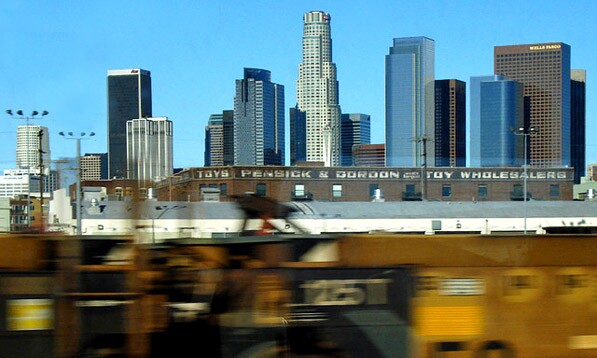Green Fading to Brown?

The Community Redevelopment Agency -- struggling to stay ahead of a deteriorating loan -- has made a deal with developer Trammell Crow to sell a 20-acre parcel in what is supposed to be the city's "clean technology" corridor.
With the sale, another piece of the mayor's legacy will turn from green to brown.
In 2009, Mayor Villaraigosa tied his second term (and his political future) to an ambitious plan that would transform four miles of industrial land along the Los Angeles River into a Clean Tech Corridor and a home for "green" industries. The corridor was supposed to be anchored east of downtown by a Cleantech Manufacturing Center, including about 20 acres of former rail yards and a bus assembly plant.
Promises that were made in 2009 were almost too green: Only "clean technology" businesses were allowed to lease space in the Cleantech Manufacturing Center, and nearly all jobs there would have to be certifiably "green" as well.
But tight credit, the site's lingering environmental problems, and the burden of so many "green" requirements turned the Cleantech Manufacturing Center into something of a white elephant for the Community Redevelopment Agency.
Its latest deal to sell the site follows repeated failures by the CRA to sign an agreement with either a manufacturer or a developer. (According to Curbed LA's James Brasuell, the CRA had tentative deals with Italian rail-car maker Ansaldo Breda, solar panel maker Applied Materials, electric car manufacturer CODA Automotive, and developer Genton Property.)
Delay put the CRA under increasing pressure to unload the property. A $15.4 million loan had to be extended twice while the CRA sought a way out.
And the agency may not be free, even now. Governor Brown's plan to drain the revenues of redevelopment agencies has put deals like this one on hold until mid-January, when the state Supreme Court is expected to rule on the legality of the governor's raid of redevelopment funds.
It's not surprising, then, that if Trammell Crow does acquire the site, the company won't have to meet the stringently "green" requirements of 2009 -- and could escape all of them by paying a surcharge of $1 million on top of the $15.4 million purchase price (making the deal a wash for the CRA, since the price is exactly the same as the CRA's 2007 loan).
While the CRA waits to see if the state Supreme Court will unburden the agency of both its loan and its environmentally tainted property, those close to the negotistions have been unusually revealing about the relationships that make these deals possible.
As reported by Ryan Vaillancourt, Staff Writer for LA Downtown News:
While the $1 million penalty for ignoring the cleantech obligations would seem relatively minor, (Bradley T. Cox, senior managing director of Trammell Crow) said there's a valuable reason to do everything possible to meet them. "We're a community-based developer and we want to be invited back," he said, referring to potential future deals with the city. "If I stiffed everybody and didn't do what we said we'd do on the first project, you think I'd get a second project? You don't do those things. It's a small town." Alex Paxton, who helped negotiate the deal for the CRA, agreed that disregard for the cleantech vision would backfire. "It would burn bridges with the mayor's office," Paxton said.
As an example of crude political realism, that may be true, but these sensitivities are unlikely to make this deal any greener in the end. It's more likely that Trammell Crow is waiting out the clock on Mayor Villaraigosa's final term, when relationships will be recalibrated.
As Vaillancourt also reported, Trammell Crow is thinking about 2013 and post-Villaraigosa:
If the firm fails to find cleantech tenants, (Cox) said the complex would likely turn toward businesses from the industries that dominate the surrounding market - wholesale produce and garment manufacturing. "If we can't execute the CRA vision, then we have an asset for some of these other users who are traditionally in the market there," he said.
The bait in 2009 was high-tech jobs for smart young men and women in a virtuous "green" economy aimed at the mayor's future. And the switch is beginning to look like sewing and hauling jobs for laborers in a gritty, "brown" economy aimed at the city's dubious present.
D. J. Waldie, author, historian, and as the New York Times said in 2007, "a gorgeous distiller of architectural and social history," writes about Los Angeles on KCET's SoCal Focus blog.
The image on this page was adapted from one by flickr user Jack Nealy. It is used under a Creative Commons License.


